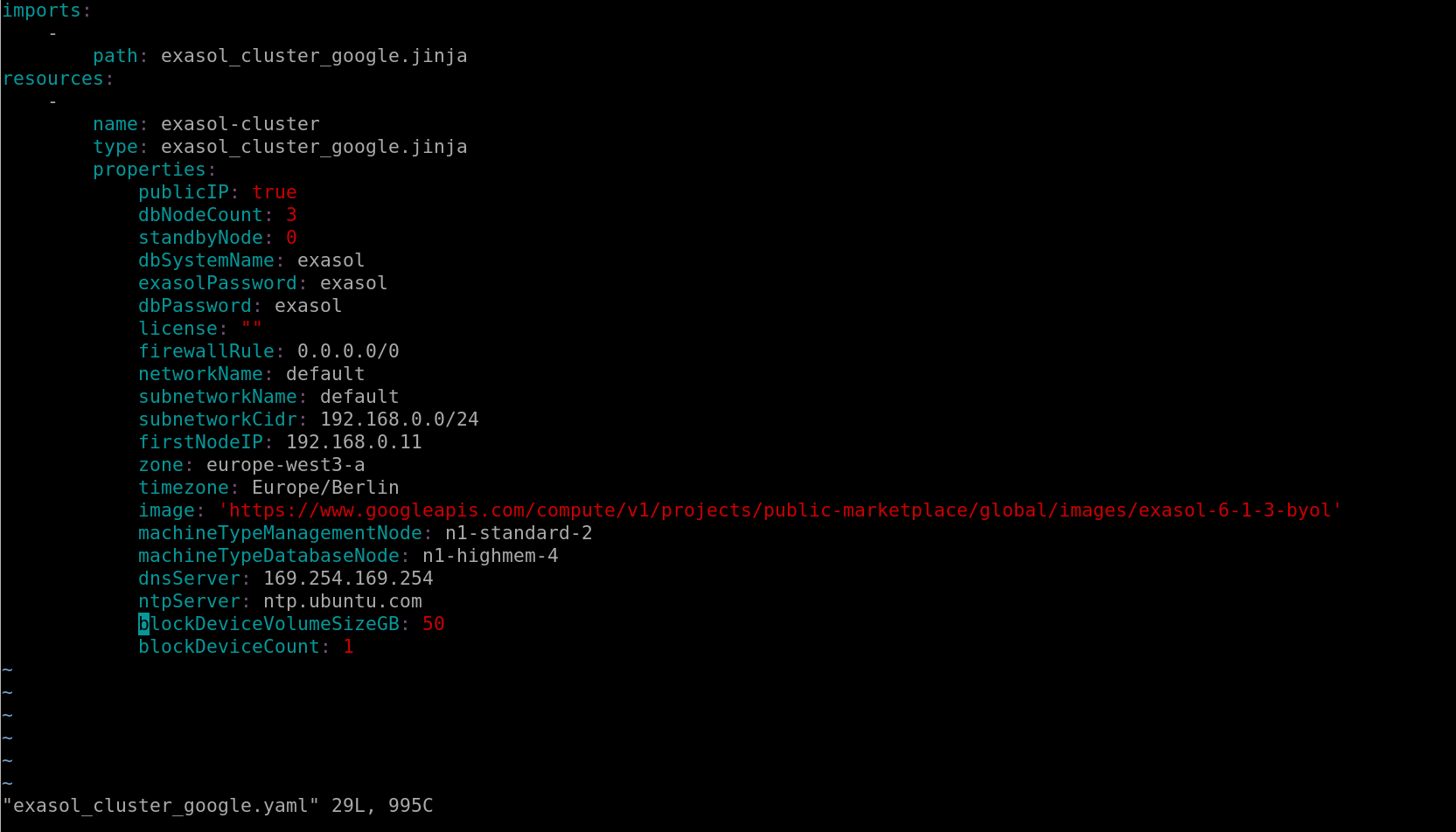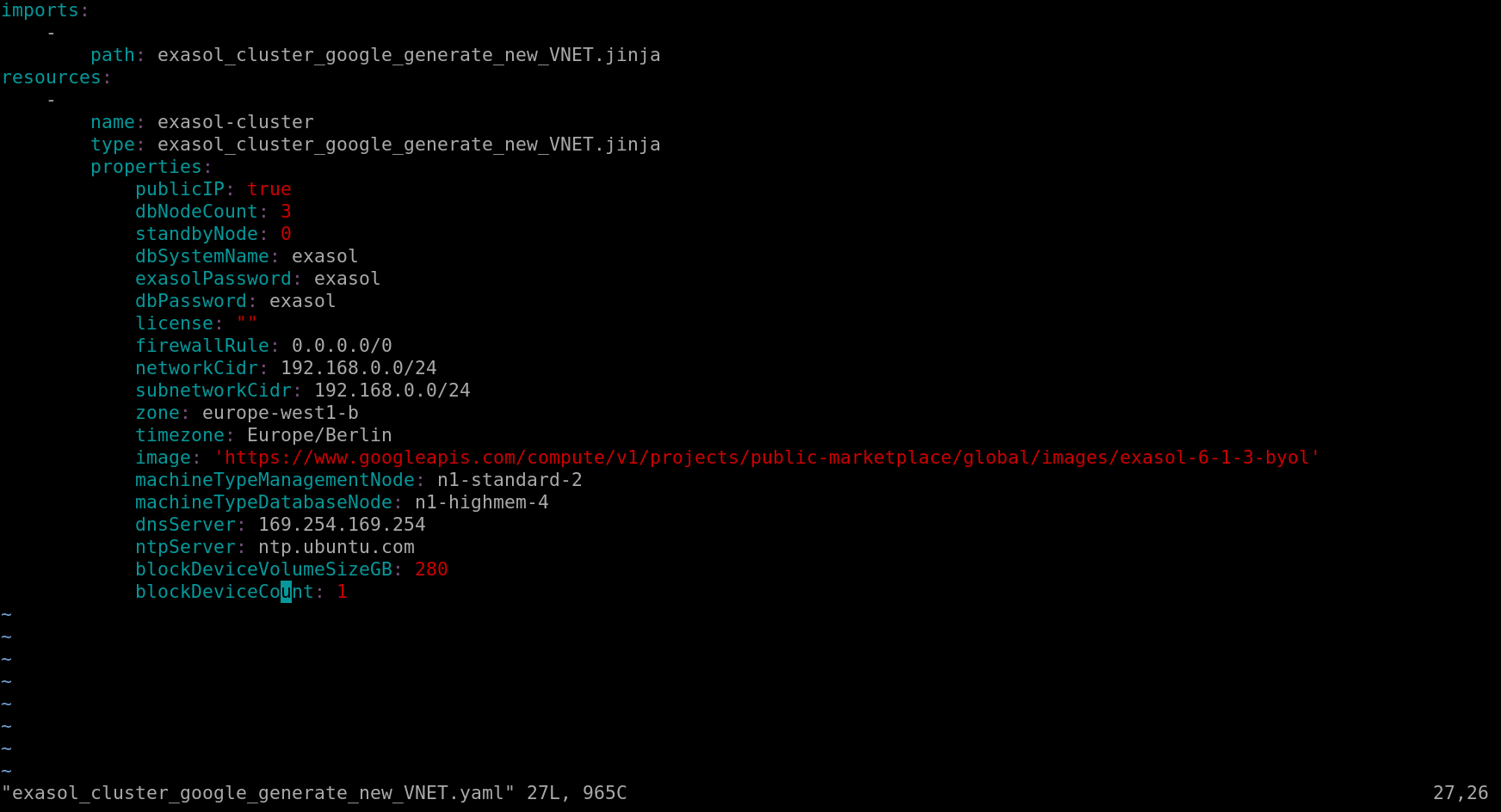Using Cloud Deployment Manager Template
This article provides you with instructions on how to deploy Exasol on Google Cloud using a Cloud Deployment Manager template.
Sizing Considerations
RAM
As a rule of thumb, the total amount of RAM of the cluster should be approximately 10% - 15% of your raw data. However, based on your use case, you may need more RAM.
Instance
Exasol recommends n1-standard, n1-highcpu, and n1-highmem category instances with more than 16 GiB of memory.
Example
Let's assume the size of raw data is 500GB. Based on the RAM thumb rule, a good configuration for this data size would be:
- n1-standard-16, 16 vcores, 60 GiB main memory
- n1-highmem-8, 8 vcores, 52 GiB main memory
Storage
Exasol recommends using SSD persistent disk for data storage and Cloud Storage for data backup. The data storage volumes should be properly sized to store the maximum recommended amount of data for this instance type, data replicas in case of a cluster configuration as well as index structures and space for temporary data.
The template configures the correct storage configuration for every instance type.
Deployment Steps
Step 1: Create Google Cloud Account
If you do not have a Google Cloud account, create one at Google Cloud Platform Console.
If you already have an account, skip to Step 2.
Step 2: Install Cloud SDK Command-line Tool
Install the Cloud SDK command-line tool by following the instruction from Installing Google Cloud SDK.
Step 3: Download the Templates
Each Google Cloud Deployment Manager template is a combination of two files (.jinja and .yaml). You need both the files for Exasol deployment. Based on your requirement, you can download the templates from the following locations:
- Exasol cluster using existing VPC:
- Exasol cluster using new VPC:
- Exasol single node using existing VPC:
- Exasol single node using new VPC:
Step 4: Deploy the Templates
Do the following to deploy the downloaded template:
-
- Run the following command if you want to deploy Exasol using an existing VPC
gcloud deployment-manager deployments create exasol-<deployment_name> --config exasol_cluster_google.yaml

- Run the following command if you want to deploy Exasol using a new VPC
gcloud deployment-manager deployments create exasol-<deployment_name> --config exasol_cluster_google_generate_new_VNET.yaml

- Run the following command if you want to deploy Exasol using an existing VPC
- Provide the values of the parameters and continue. To know about the parameters, see Template Parameters.
Launch Instance
Once the instance is in running state, you can connect to it using the IP address or the DNS name displayed in the console. To launch the instance, follow these steps:
- Copy and paste the IP address or the DNS name of the instance in a browser.
- You will receive a digital certificate to confirm. Once you have confirmed this, the installation is initialized, and the following screen is displayed.
- Once installation is complete, you will be redirected to the EXAoperation screen.
It may take up to 45 minutes for the EXAoperation to be online after deployment.

Template Parameters
The following table lists the parameters used in the templates and their descriptions.
| Parameter | Description |
|---|---|
| publicIP |
If set to true, public IP addresses are assigned to all instances. |
| dbNodeCount |
Number of cluster nodes. |
| standbyNode |
Specifies the number of standby node(s) that you want to add for failover. The replication factor is automatically set to two if there is more than one node in the system. You can implement any of the following two standby modes:
To learn more about how these standby modes work, see Fail Safety (Cloud). |
| dbSystemName |
Name of the generated database. |
| exasolPassword |
Password for the Exasol operations admin user (EXAoperation 'admin' user). |
| dbPassword |
Password for the Exasol database admin user (Exasol ' |
| license |
In case of a BYOL image an already acquired license can be pasted here as string. |
| firewallRule |
Restrict access to specific ip addresses (0.0.0.0/0 results in access from everywhere). |
| networkName |
Target network |
| subnetworkName |
Target subnetwork |
| networkCidr |
CIDR Block of the target network. |
| subnetworkCidr |
CIDR Block of target subnetwork. |
| firstNodeIP |
Counting upwards for the IPs of the data nodes (FirstDataNodeIP > LicenceServerIP). |
| zone |
Target zone where instances and persistent disks are deployed into. |
| timezone |
Required timezone for the DB (default Europe/Berlin). |
| image |
VM Image from the Google Marketplace Solution. |
| machineTypeManagementNode |
For example, n1-standard-2. |
| machineTypeDatabaseNode |
For example, n1-standard-4. |
| dnsServer |
For example, 169.254.169.254 (Google Cloud internal DNS Server).
|
| ntpServer |
For example, ntp.ubuntu.com. |
| blockDeviceVolumeSizeGB |
Devices size for data volume. |
| blockDeviceCount |
Number of storage volumes for each node. |
Next Steps
Connect to Exasol
After installing Exasol on Google Cloud, you can do the following:
- Install drivers required to connect to other tools.
- Connect SQL clients to Exasol.
- Connect Business Intelligence tools (BI tools) to Exasol.
- Connect Data Integration - ETL tool to Exasol.
- Connect Data Warehouse Automation tools to Exasol.
Load Data
After you have connected your choice of tool to Exasol, you can load your data into Exasol and process further. To learn more about loading data into Exasol, see Loading Data.
Administration
For the maintenance tasks related to Exasol on Google Cloud, see Administration (GCP).
